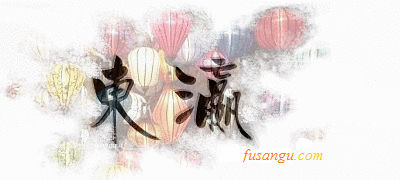
In this page we describe a 2-week itinerary which makes for an excellent first journey to Vietnam. It is a classic south-to-north itinerary, which will allow you to discover some of the country’s main historical landmarks as well as its sheer variety in cultural and natural landscapes.
The article is the result of numerous journeys taken in different seasons over the span of more than 10 years. As a consequence, when we give suggestions as to how choose the destinations and allocate time, we have a clear understanding of the priorities that most people might have.
Each day of the journey is given a full description, which includes tips for possible modifications and variations.
At the end we give suggestions on how to change the programme according to the specific time of year when you plan to travel.
Two-week Vietnam itinerary: essential information
Duration: 2 weeks (15-16 days depending on the flight itinerary)
Starting point: Ho Chi Minh City
Ending point: Hanoi
Suggested stopovers: Ho Chi Minh City, Singapore, Bangkok, Kuala Lumpur, Hong Kong
Destinations: Ho Chi Minh City, Mekong Delta , Hoi An, Hue, Hanoi, Sa Pa, Ha Long Bay
Main features of the journey: the itinerary includes the main must-see destinations, especially the cities of historical significance. It is most suitable to those who are fond of exploring cultural differences and art. The pace is fast but not hasty and allows for appreciation and slow travelling experiences.
Best time to travel: beginning of spring
Budget:
-
1.000 – 1.400 euro (backpackers, young couples)
-
1.800 – 2.100 euro (mid-range, comfort with occasional luxury experiences)
Variants: by adding 2-3 days it is possible to include a seaside stay in Mui Ne, Da Nang, Nha Trang, Quy Nhon or Con Dao Islands.
First journey to Vietnam: how to choose the destinations
As you prepare to visit Vietnam for the first you will most likely want to travel between north and south to have an idea of the country’s fascinating variety in natural and cultural landscapes.
A classic itinerary, which is what we are to describe hereafter encompasses these destinations: Ho Chi Minh City, Hoi An, Hue, Hanoi, Sa Pa and Ha Long Bay.
As you might have noticed, we suggest a south-to-north course. In our opinion this corresponds to a noticeable crescendo in beauty and variety of the travel experience. A cruise in the Ha Long Bay should be a sufficient reason to prove this.
In general if you include destinations in the northern mountainous region a north-to-south course is more advisable in some periods of the year but being Sa Pa the only such destination you can stick to the following itinerary in any season.
Hanoi and Ho Chi Minh City are Vietnam largest cities. They are home to a great number of sites of historical and cultural significance and offer invaluable opportunities to get to know the history of the country, both the ancient and the modern ones. They are so diverse and their contrasts so sharp (albeit this is changing) that the two destinations would already be enough to make for an inspiring journey.
From the two cities you can have interesting side trips. Ho Chi Minh City is the ideal base to visit the Mekong Delta (as 1 or 2-day trip). From Hanoi you can move to visit Ninh Binh (1-day excursion), Sa Pa and Ha Long Bay (2 or 3-day excursion). As two weeks is limited time, you have to resort to the support of local or on-line agencies for these excursions. Offer is plenty and diverse.
Along the Ho Chi Minh City - Hanoi route classic destinations are Hoi An and Hue, smaller cities full of vestiges of the past. These are the places that you cannot miss out on if you are passionately fond of art and beauty.
Hoi An is a Vietnam architectural gem, of the few cities which survived devastations brought about by time and wars. Its large scale coherent historic centre is unique in Vietnam. In the surroundings you can visit Cham Islands or, if you are into archaeology, the majestic My Son Sanctuary.
Suggested Vietnam itinerary
The following itinerary is crafted for those who want to make the most of out of their time and yet wish to avoid a hasty tour-de-force. While the pace is undoubtedly intense you will have plenty of time to enjoy the experience and comprehend what you see.
For each day we provide suggestions on how alter the programme, adding or replacing destinations.
Starting point
Many people start and finish their journey in Vietnam in Ho Chi Minh City because its airport (SGN, Tan Son Nhat Airport) is the main international hub of the country.
An increasing number of international routes now connect also the capital, Hanoi. If you come from a country located in South-east Asia (Cambodia, Singapore, Thailand, Malaysia) or East Asia (China, Japan, Korea) you can also fly into Da Nang or Nha Trang.
If you want to spare time and money you may want to spend some time looking for convenient multi-city flights.
For this itinerary it would be best to enter the country through Ho Chi Minh City and exit through Hanoi.
Duration
The itinerary takes up 14 full days. Depending on your travel arrangements, the entire journey may last 15-16 days.
How to allocate time
For this itinerary time is allocated according to the following schedule:
-
Ho Chi Minh City (including an excursion to the Mekong Delta): 2 days
-
Hoi A: 2 days
-
Hue: 1 day
-
Hanoi: 2 days
-
Ha Long Bay: 2 days
-
Sa Pa: 2 days
Four half-days are absorbed by long distance transfers (Ho Chi Minh City - Da Nang by plane; Hoi An - Hue by bus or car, Hanoi - Sa Pa and return)
Some of these transfers allow to see scenic places and are quite enjoyable. Particularly interesting is the journey between Hoi An and Hue, along which you can easily add a couple of stops.
|
Days |
Destinations (length of stay) |
|
· 1 - 3 · 4 · 5 - 6 · 7 · 8 · 9 - 10 · 11 - 12 · 13 - 14 |
· 3 days in Ho Chi Minh City and the Mekong Delta · ½ day for the journey to Hoi An; first visit in the afternoon · 2 days in Hoi An (possible trips to Cham Islands or My Son) · ½ day for the journey to Hue; first visit in the afternoon · 1 day in Hue, night train journey to Hanoi · 2 days in Hanoi, night train transfer to Lao Cai and bus to Sa Pa · 2 days in Sa Pa and surroundings (Muong Hoa Valley) · Ha Long Bay cruise; return to Hanoi; end |
Domestic transfers: suggested solutions
As for the internal transfers, many options are available. We will consider two solutions:
-
By plane: the easiest and most comfortable way to travel on long-distance legs, such as Ho Chi Minh City (or Can Tho) - Da Nang, Hue - Hanoi, Hanoi - Ho Chi Minh City.
-
By night train: a fascinating way of travelling, suitable to legs such as those mentioned above and between Hanoi and Sa Pa.
We suggest you do not consider travelling by bus because despite being the cheapest way of getting around in the country, this means of transportation is not compatible for such a short journey. If you can stay in Vietnam for at least 20 days or you cut out a couple of destinations, then travelling by bus becomes feasible.
Summarising, this is the suggested plan:
-
Ho Chi Minh - Da Nang: by train or plane
-
Da Nang - Hoi An: by bus, shuttle bus or taxi
-
Hoi An - Hue: by bus or taxi or by train (from Da Nang to Hue)
-
Hue - Hanoi: by train or plane
-
Hanoi - Sa Pa: by bus or by train (to Lao Cai) and bus
-
Hanoi - Ha Long Bay: transfers are provided by the cruise operator
Variant: transfer from Can Tho to Da Nang
As shown later, you can choose to visit Can Tho instead of destinations closer to Ho Chi Minh City. If you do so, it is easier to continue the journey by flying from Can Tho to Da Nang directly, without having to go through Ho Chi Minh City again.
Where to stay
For this journey you will need to stay in almost all destinations. Only the Mekong Delta can be visited with a side trip from Ho Chi Minh City but it is better to spend there at least a night.
In all the destinations hotels and hostels of good quality can be found. The offer is wide and for any budget.
Brief description of the journey
We assume that you can start visiting Ho Chi Minh City in the early morning of the first day. This can happen either if you spend the previous night in the city or if your flight arrives early in the morning (which is often the case if you come from Europe).
Day 1 – Ho Chi Minh City | arrival; District 3, Ben Thanh and Ben Nghe
Once you have gone through immigration and customs formalities go to your hotel.
Visa
Find information about requirements and procedures to obtain a visa for Vietnam through the official channels available in your country.
Citizens from few countries benefit from a visa-free regime, which allows for stays of duration up to 15 days for the purpose of tourism. There are a number of restrictions and conditions limiting access to this opportunity. Again, verify and enquire into what situation applies to your case.
Purchase of a local SIM card
You can buy a sim card at the airport, in the city or on-line. Cheap plans (around 300.000 dong) for data connection can be ordered on-line. If you buy a sim in a shop you will be asked to show your passport for registration. This does not happen if you buy the card in the street but swindles are possible.
Transfer from the airport to the city centre
A two-day stay requires you to stay in the centre or in its surroundings. You can get there from Tan Son Nhat Airport by bus or taxi.
By bus
Public bus Line 152 offers the cheapest option (only 5.000 dong per person). It can be crowded and there is not much spare for large pieces of baggage. Larger and more comfortable but more expensive (20.000 dong) is the ride by bus (Line 109).
Both buses go through Phu Nhuan, District 3, Ben Nghe, Ben Thanh. Bus 109 reaches the notorious phuong of Pham Ngu Lao (the backpacker’s area) while bus 152 ends its service near Ben Thanh Market.
Travel time is 30-40 minutes.
By taxi
A ride by taxi from the airport to the city centre takes around 20-30 minutes and costs less than 150.000 dong. Reliable and reputable companies are Mai Linh, Vinasun and Futataxi. Make sure the metre is used.
Where to stay in Ho Chi Minh City
As you have to get around by taxi (the public buses are not an option for such a short stay), it is not necessary to stay in the centre. If you like getting around on foot, which is most interesting in such a dense and diverse city, do stay in the centre.
Ben Nghe is the centre of District 1 and the most glittering area. Full of good restaurants, a few sightseeing spots, a good share of the city’s colonial heritage, the neighbourhood is quite pleasant and not all hotels are expensive. A few gems are quite cheap indeed.
Cheap family-run guest houses can be found around Ben Thanh Market. If you like a quiet environment, focus your search on the area south of the market.
Lots of mid-range good value for money hotels are located along Ly Tu Trong Street. All these areas are perfect places to start walking itineraries.
We suggest you avoid the backpackers’ area, an unsafe, dirty and chaotic place, especially if you are a light sleeper.
Even if you want to spend your nights there, convenient hotels and hostels between Pham Ngu Lao and Ben Thanh Market offer way better of solutions.
If you plan to move around only by taxi and want to stay in a high-profile hotel, District 3 is a good alternative to Ben Nghe.
First visit
The first impact with the reality of modern-day Saigon is quite a shock. Noise, confusion, traffic, pollution and humid heat can be a shock.
For the first day it is better to take part in a comfortable guided tour.
12:30 – 14:30: War Remnants Museum
If you are not into war museums, make sure you do not miss out on this one at least. Its name, diplomatically softened over the years, is quite deceptive because while a variety of military equipment is present, it does not make for the most important exhibits on display and certainly not the reason why you should come here.
The museum offers an invaluable opportunity to get to know the horrors of the Vietnam War (the Second Indochina War) from the Vietnamese perspective.
Starting from the top floor and going all the way down you will see photos, documents, maps and a variety of informative material. Exhibits include tanks, aircraft, a guillotine and the infamous tiger cages.
The experience can be quite intense and moving. Most shocking are the pictures showing the effects of the mass usage of defoliants and chemical agents on Vietnamese civilians.
The museum is located in District 3, not too far from the centre.
14:30 – 15:00: From District 3 to the Jade Emperor Temple
A taxi ride from the War Remnants Museum to Jade Emperor Temple should take less than 15 minutes, traffic permitting, and cost less than 100.000 dong.
15:00 – 15:45: Jade Emperor Temple
As time is limited, you may choose to skip a visit to Cho Lon, a former independent city, home to a large community of hoa (overseas Chinese, mostly hailing from Canton and Fujian provinces).
However you can still visit an interesting Chinese temple without going far from the city centre. This is the Jade Emperor Temple (Chùa Ngọc Hoàng, 玉皇寺, 玉皇殿), dedicated to the supreme Taoist deity.
Richly decorated, the temple is most atmospheric when it is not crowded. There are a number of halls where different deities are worshipped.
15:45 – 16:15: From the Jade Emperor Temple to the Independence Palace
A taxi ride from the Jade Emperor Temple to the Independence Palace should take less than 20 minutes and cost less than 100.000 dong.
16:15 – 17:00: Independence Palace
The Independence (or Reunification) Palace is the symbol of the end of a three-decade struggle for the independence of Vietnam. You will like this visit if you are interested in history or modern architecture.
17:00 – 20:00: Le Duan Avenue, Notre Dame Cathedral, Post Office, Dong Khoi Street, Nguyen Hue Street,
The first day tour ends with the most recognisable remnants of the colonial Saigon. From the Reunification Palace a short walk along Le Duan Avenue (named after one of the most celebrated strategists of North-Vietnam), leads to the iconic Cathedral of Notre Dame and the Central Post Office.
You can then wander around Dong Khoi and Nguyen Hue Street, the walking area of the local inhabitants. A lot of buildings in the Liberty style are found in this area.
Day 2 – Ho Chi Minh City | Cu Chi Tunnels and Cho Lon
The second day is spent in the periphery of the city. Tours are very cheap and some are of good quality. Reaching the destination by bus is advisable only to those who have more time.
7:00 – 12:00: Cu Chi Tunnels
The Cu Chi Tunnels are a small section of the huge network of underground tunnels and bunkers which played a fundamental role in the resistance and counter attack strategies employed by the Vietnamese in both Indochina Wars.
Part of the supply lines, the tunnels provided shelter against bombings and served as living quarters, hospital and even schools throughout the duration of the conflict. They were also used to penetrate into the territory controlled by the enemy, thereby allowing for flexible guerilla tactics and sorties.
Even though the tunnels have been made wider and are partially lit, you cannot help but feel a deep sense of anguish and oppression.
It is recommended to visit the tunnels by taking part in a group tour. Some also include transportation by fast boat.
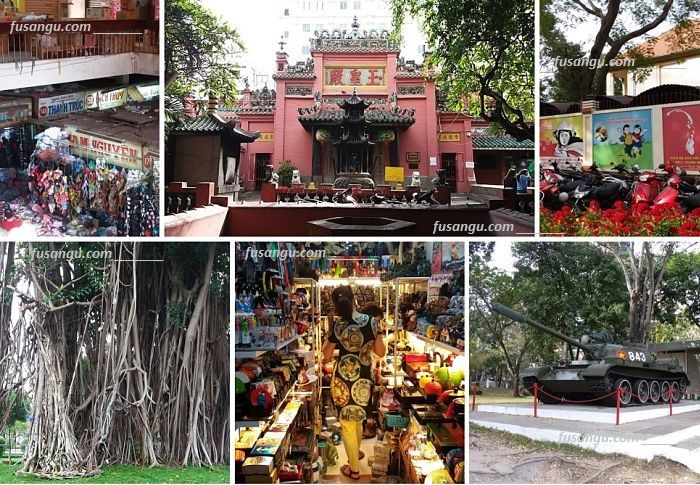
14:00 – 17:00: Cho Lon
Formerly an independent city, home to large communities of hoa (overseas Chinese), Cho Lon is a large quarter of modern Ho Chi Minh City.
Despite widespread destruction brought about by the last war, mostly during the Tet Offensive, Cho Lon has still a number of old temples which definitely deserve a visit. They display beautiful GuangDong and FuJian architecture and the atmosphere echoes the past of the city like no other place.
A visit to Cho Lon might follow this order:
-
Ong BonTemple (Hoi Quan Nhi Phu)
-
Quan AmPagoda
-
Thien HauTemple
-
Ha ChuongTemple
All these temples are served by buses departing from the centre (Phan Ngu Lao). In Cho Lon is a Binh Tay Market, a valid alternative to the more touristy Ben Thanh Market.
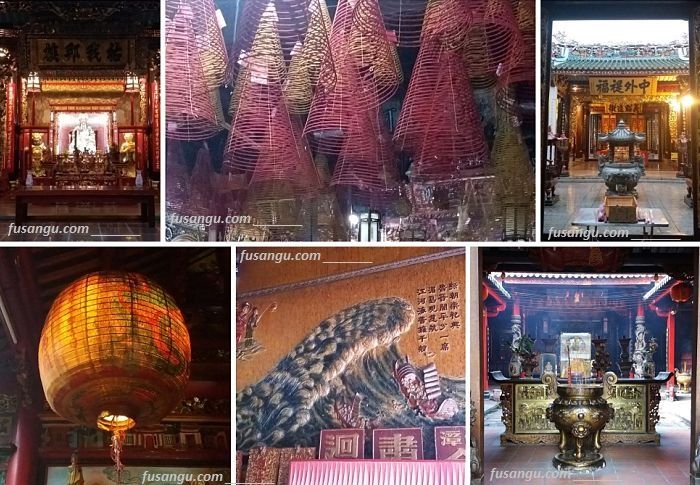
How to get to Cho Lon
You can reach Cho Lon by taxi or bus. The ride by taxi from the centre costs 150.000-200.000 dong. Much cheaper the ride by bus (Line 1; less than 10.000 dong).
Related articles:
TP Ho Chi Minh 3-day itinerary
Day 3 – Ho Chi Minh City | excursion to the Mekong Delta
A full day is spent for a trip to the Mekong Delta, one of Vietnam’s most interesting natural and cultural landscapes. Most one-day programmes revolve around Ben Tre and My Tho.
If you want to visit a floating market you can choose among Cai Be and Can Tho. The latter requires spending a two-day trip. This solution is presented at the end of this page.
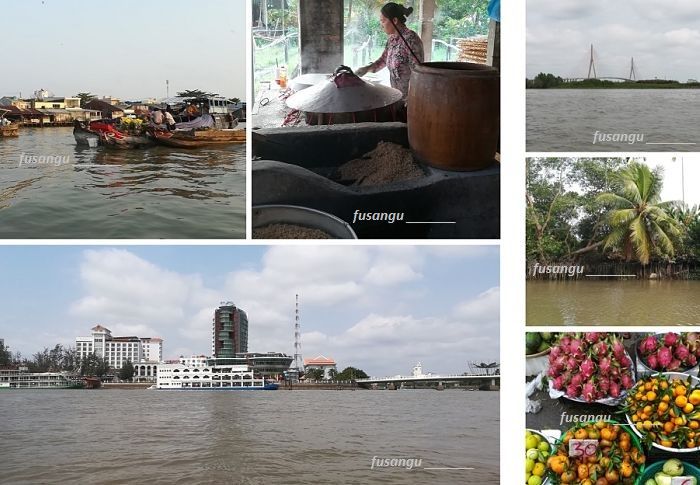
Day trip to Mekong Delta from Ho Chi Minh City
Ben Tre and My Tho lie near Tien Giang, a branch of the Mekong River. As they can be reached from Ho Chi Minh City in less than 3 hours, they are the most suitable destination for day trips from this city.
A great deal of tours and excursions are offered. They vary in content but most of them include a tour of the jungle and the fascinating maze of canals that criss cross the province on board of sanpan and canoes, a local style lunch, visits to one or two villages and hands-on activities which are meant to introduce the visitor to the local culture and lifestyle.
On the way back some tours include a visit to Vinh Trang Pagoda, an atmospheric temple combining stylemes of European and Oriental architecture.
Day 4 – Transfer to Da Nang and Hoi An | walk in Hoi An’s city centre
From Ho Chi Minh City (or Can Tho) you can reach Da Nang by plane. You can also travel by night train. Low cost flights usually offer the cheapest option
Morning: flight to Da Nang and transfer to Hoi An by shuttle bus or taxi
There are many flights between Ho Chi Minh City and Da Nang. Flight time is less than 90 minutes. If you factor in the time lost for transfers, check-in, customs procedures, you most likely have to take into account a total of 4-5 hours for the journey. Prices vary between 1.000.000 and 2.000.000 dong (except during Tet when fares can be considerably higher).
From Da Nang Airport you can reach Hoi An by shuttle bus or taxi in less than 1 hour. Price is 200.000-300.000 dong.
Where to stay in Hoi An
Even if Hoi An is a small city, when choosing where to stay you should pay some attention. First of all, be aware that there is plenty of accommodation for any budget.
As time is limited, you may want to base yourself not far from the centre. Getting around by taxi is cheap but you can also use a bicycle (most hotels and guest houses offer them for free).
For a 2-4 day stay like in this case, we suggest you choose among the centre and Cam Chau.
These are the best options:
-
Minh An, in the heart of the historic town, the most fascinating place;
-
Cam Chau, between the historic centre and the northern beaches, ideal location if you want to explore the countryside and get off the beaten tracks;
-
An Bang, near the beaches.
Afternoon
The first contact with Hoi An can simply be a relaxing walk in the centre. Hoi An historic centre is unique in Vietnam. No other city in the country can boast such a beautiful and well-preserved historic centre. From traditional local houses to colonial buildings, the area is a fascinating blend of tangible heritage that displays influences from Chinese, Japanese and local architecture.
Many of Hoi An’s most beautiful architectures are found along Tran Phu and Bach Dang streets. These are the most touristy places but if you cannot stand the crowds, a simple turn into a backstreet will immediately project you into a totally different dimension, that peaceful, quiet, atmospheric old town where time flows slowly.
If you cannot wait and want to exploit the little time available, you can immediately add a few cultural visits, such as Hoi An Ceramics Trade Museum or one of the sino-vietnamese halls.
If you want to see the ordinary non-touristy town, just cross the Thu Bon River and wander in Cam Nam Island.
Do not forget to purchase the tourist tickets (120.000 dong). Each allows you entrance to five sightseeing spots. We suggest you buy two tickets. Ticket offices are in the old town, near Quan Cong Temple and near the Japanese Bridge.
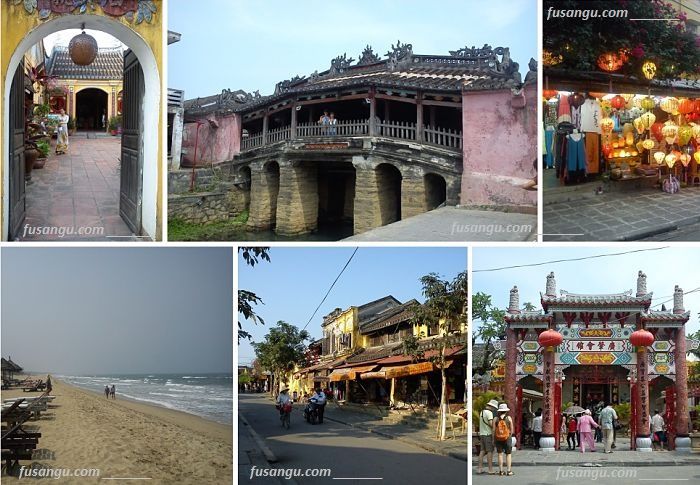
Day 5 – Hoi An | historic centre (temples, sino-vietnamese assembly halls, museums)
A day is enough to see a significant part of Hoi An’s cultural heritage. We suggest you choose the following sites:
-
A historic pagoda
-
A Taoist temple
-
One or two assembly halls
-
One or two ancient houses
We suggest you start your sightseeing day very early, so as to have the chance of seeing Hoi An in peace and tranquillity. In this way you can also find time to have a siesta around noon, a time when the heat can become unbearable.
6:30 – 7:30: Minh An
Hoi An at dawn is still the quaint and adorable city that it used to be. The streets are quiet and the sights will not be ruined by cheap and out-of-place merchandise. This is the only time when you can really appreciate the old architecture, distinguish the different styles and notice decorations and features you will most certainly miss amid the confusion.
7:30 – 9:00: Japanese Bridge, Canton Assembly Hall, Phung Hung Old House
Very close to each other are three of Hoi An’s most famous architectures: the Japanese Bridge, Canton Assembly Hall, Phung Hung House (Chua Cau, Hoi Quan Quang Dong and Nha Co Phung Hung).
What is known under the name of Japanese Bridge is a small temple (Chua Cau, “Bridge Temple”). The tiny place of worship is found on a room built on a masonry bridge covered by a richly decorated tile roof. As you can imagine, the temple was found by the local Japanese community.
A beautiful sight encompassing the bridge can be had from the upper floor of Phung Hung Ancient House. The beautiful two-storey building served as residence and shop for an affluent family of merchants. The wooden structures and the furniture are particularly elegant.
A few steps towards east will lead to the Cantonese Assembly Hall (Hoi Quan Quang Dong). A Taoist temple, it serves as meeting point and social venue for the sizeable Chinese community hailing from GuangDong Province.
9:00 – 11:30: Bach Dang, Tan Ky Old House, Fujian Assembly Hall
Many beautiful colonial period houses are lined along Duong Bach Dang, the northern embankment of the Thu Bon River.
As you move from the Cantonese Assembly Hall you will immediately spot Tan Ky Ancient House. This is a very beautiful merchant house with a central yard. The house is marked by a board with Chinese characters. The building is a unique combination of Vietnamese, Chinese and Japanese architectural stylemes.
Once you have reached the Hoi An Market, spend so time wandering inside and outside the large building. Do not forget to taste the local fruits, delicious and healthy.
You can then proceed towards Tran Phu and visit Quan Cong Temple, place of worship devoted to the mythical Chinese general and the small and atmospheric Quan Am Pagoda.
Moving westwards along Tran Phu, the most touristy street in Hoi An, are many cultural sightseeing spots. We suggest you take some time to visit the Fujian Assembly Hall, the largest and most impressive hoa assembly hall in the city. The decorations of the roof are the most recognizable mark of Fujian sacred architecture.
11:30 – 14:30: Lunch break
If you visit Hoi An between May and September the heat will definitely be intense and you might want to take a long break around noon.
14:00 – 18:00: Activities
Hoi An is a small city and it is easy to get around in its surroundings. Therefore there is plenty of choice as to how spend the afternoon. We suggest choosing among the following options:
-
Visiting HaiNan and ChaoZhou Assembly Halls and stroll along the Thu Bon in Cam Nam Island;
-
Cycling in Cam Chau and Cam Thanh, beautiful countryside localities just east of the centre;
-
Relaxing on the beach in An Bang or Cua Dai (between March and September);
-
Visiting Marble Mountains, a Buddhist religious site nestled in a group of small hills between Hoi An and Da Nang. You can also add a visit to Da Nang’s Cham Sculpture Museum if you plan to visit My Son the next day.
Day 6 – Hoi An | visit to My Son Sanctuary or Cham Islands
The third day in Hoi An can spent for an excursion to My Son Sanctuary. In order to make things easy, it is best to join a tour. Some trips start early in the morning, so as to avoid crowds. This little sacrifice will be rewarded with the pleasure of visiting the site in an atmosphere of quiet and mystery.
Travelling by bike is possible but not recommended as the road, especially the section between Hoi An and Nam Phuoc is dangerous.
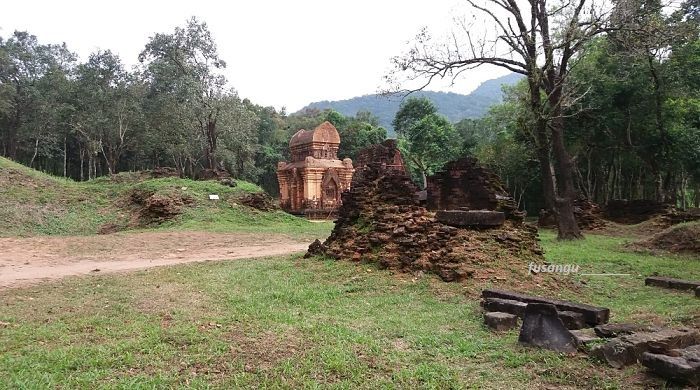
Morning
Southern and Central Vietnam were previously part of the Kingdom of Champa. Its population, probably of Javanese origin, used to practise Hinduism. With the push towards south of the Kinh (the ethnic Vietnamese) the Champa gradually lost territory and their state collapsed.
Many temples and vestiges of the Cham Kingdom can be found today, especially in Ninh Thuan and Binh Dinh provinces but no site reaches the beauty and importance of My Son Sanctuary.
At a distance of 30 km from Hoi An, it makes for a perfect half-day trip from the city. The visit also allows you to have a glimpse of the countryside landscapes in Quang Nam Province.
The sanctuary lies in a basin covered by a thick jungle. Rivers cross the valley, surrounded by mountains on three sides. The choice of the site was made as to follow precise cosmologic notions.
The religious site, the spiritual centre of the Kingdom of Champa, comprised a large number of temples of outstanding size and artistic value. Aside from their beauty, the visitor will be impressed by the symbiotic relation between architecture and environment.
Nowadays only a small part of the ancient complex is standing. Tremendous damage was inflicted by a bombing occurred during the Vietnam War, supposedly, because Viet Cong were hiding in the valley (this is somewhat disputed though).
Afternoon
If you want to visit another religious site you can get back to Hoi An and reach the Marble Mountains.
Otherwise you can choose among the options listed in the previous paragraph or just relax in Hoi An.
Related articles:
Day 7 – From Hoi An to Hue
A direct car or bus transfer between Hoi An and Hue takes 4-5 hours. If you choose this solution you have some free time to spend either in Hoi An, Hue or, along the way, in Da Nang, where you spend a few hours on he beach.
Another option, which is what we present here, is to add a few stops along the way:
-
Son Tra Peninsula, just north of Da Nang, a beautiful area, largely untouched by tourism. There are a few coves and nice beaches where you can rest. Not to be missed is an ancient banyan tree, which is regarded as a sacred plant.
-
Hai Van Pass, a famous spot, particularly loved by those who like travelling by motorcycle. Embodiment of the very concept of natural border, it has long been celebrated by poetry owing to the beauty of the landscape and the frequent mist which emphasizes a sense of mystery;
-
Lang Co, a seaside village. It houses a few mid-range resorts. The beach is nice but the lagoons behind the town are even more scenic.
If you stop at all three places you will need an entire day and it is recommended you leave Hoi An early in the morning.
A taxi offers the most flexible solution but if you seek to keep the expenses low you can join a tour. Nowadays quite a few companies offer transfers between Hue and Hoi An that include stops in the aforementioned places. A ballpark figure for such tours is 700.000 dong.
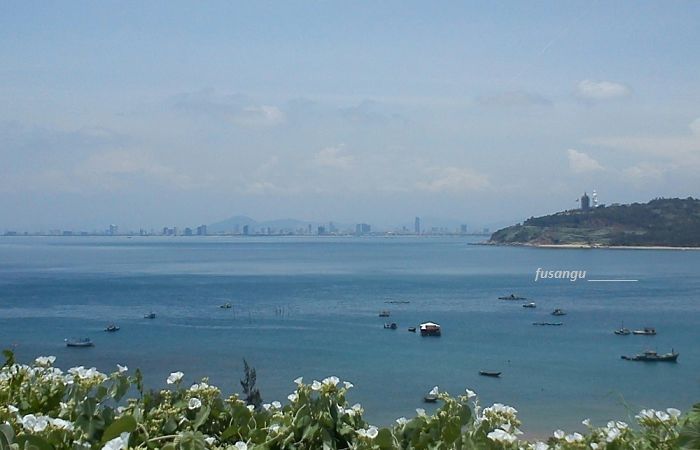
Where to stay in Hue
Hue has a large offer of accommodation. Prices in Hue are comparatively lower than Hoi An and Hanoi. Indeed, Hue is the best place to focus on if you want to allow yourself some luxury without spending too much.
There are plenty of hostels, cheap inns and a few mid-range value for money hotels in the centre, near the Nguyen Cong Tru street. The context is very touristy, noisy and quite dull though.
If you look for an extraordinary context amid vast natural landscapes you can choose to base yourself outside the city centre, where you can find a number of high-level resorts.
Evening walk
Hue’s city centre was ravaged during the last war and almost nothing of the old city is left. Therefore the area is quite uninteresting and the riverside is the only place where you can have a pleasant stroll.
Day 8 – Hue | Thien Mu Temple, Imperial Citadel, Nguyen Tombs
One day is very little time in Hue. With such limits it is advisable to follow a classic itinerary:
-
Thien Mu Temple
-
Imperial Citadel
-
Nguyen Tombs (Lang Minh Mang, Lang Tu Duc)
This itinerary includes some of the most important historical sites and allows to get a glimpse of the beautiful countryside landscape around Hue.
How to get around in Hue
To reach the main cultural and historical sights in Hue you need to hire a driver or rent a bike. Most hotels can provide for both needs. Prices are very reasonable and small groups (even 3-4 people) will find it convenient to get around by taxi.
Alternatively you can join a tour. Some include a short boat ride along the Perfume River. Accessing Thien Mu Temple from the river is very beautiful.
Getting around by bike is cheap (a day rental starts at 150.000 dong) but definitely dangerous, as in the rest of Vietnam. Discard the idea if you are not an experienced driver.
Itinerary in Hue
This itinerary is for those who enjoy slow travelling. There is plenty of time to observe and understand.
7:00 – 8:00: Thien Mu Temple
Thien Mu Temple is one of Hue’s most ancient and beautiful temples. It lies on the northern shore of the Perfume River, in a dominant position that allows views over the vast natural landscape.
Very close to Chua Thien Mu are vestiges of the Van Mieu, a confucian temple dedicated to those who nurture knowledge and ritual site linked the Imperial Citadel.
8:30 – 10:30: Imperial Citadel
Across the river from the centre of the modern city is the Imperial Citadel. Built by the first Nguyen regent it is was the seat of power of the last dynasty of Vietnam. At the time of its foundation Hue had grown into the political, cultural and religious centre of a unified Vietnam.
Oriented to face the Perfume River in accordance to precise philosophical, the complex was built to create a perfect balance with the surrounding landscape.
The structures, which comprise a great number artistic palaces, pavilions, gardens, temples, gates and enclosure walls, where aligned in a composition that reflected ancient cosmological principles. The core of the citadel are the Imperial Citadel, residence of the emperor, and the Purple Forbidden City. The fortress is protected by a system of canals connected to the river. Along with a defensive purpose they served as waterways.
The citadel suffered incommensurable damage due to neglect, inclement weather and wars. A patient work of reconstruction has saved some of the most notable buildings.
The complex is very large and in two hours and a half you should make choices in your visit. We suggest you do not miss the grandiose buildings aligned along the central axis (most notably the Hall of Supreme Harmony (Điện Thái Hòa, 太和殿) and the temples situated at the south-western corner, among which the astonishing The To Mieu.
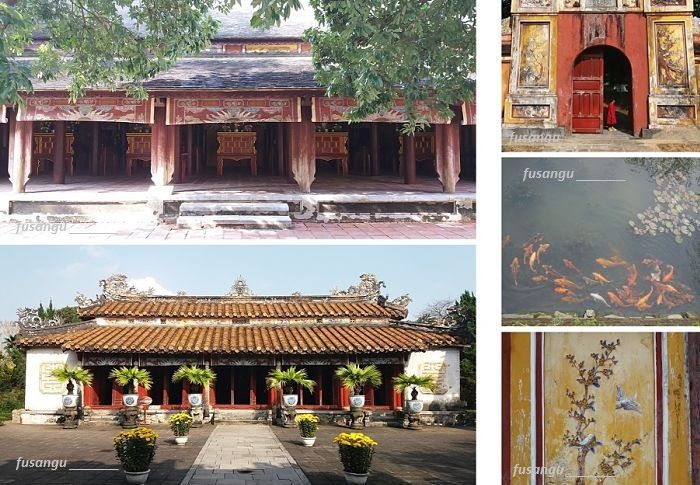
10:30 – 12:30: Dieu De Pagoda, Bach Dang, Dong Ba Market, lunch break
Not far from the citadel there are a few sightseeing spots which are often neglected by foreign tourists. We suggest you visit the Dieu De Pagoda, a historic temple with a tranquil atmosphere situated along Duong Bach Dang, one of the few streets where your spirit can build on visual clues to recreate images of the old city.
Nearby is Dong Ba Market a lively and bustling place full of stalls selling a great variety of items and local produce.
Restaurants can be find anywhere. Hue is famous for its high-quality vegetarian cuisine.
14:00 – 17:30: Visit to two or three imperial tombs (Lang Minh Mang, Lang Tu Duc)
South of the citadel, immersed in a bucolic and lush landscape, are the tombs of the Nguyen Emperors.
Half day is too little time to visit all tombs. Some of them are quite far from each other and from the city centre.
We suggest you include in your journey at least two mausoleums, those of Minh Mang and Tu Duc emperors’, which are often considered the most impressive and beautiful.
Lang Minh Mang
Among Hue’s imperial mausoleums, the tomb of Emperor Minh Mang stands out for its scale and majesty. Built in accordance with tradition, the complex comprises several large building and vast gardens set in perfect harmony with the natural landscape.
The beautifully adorned main halls are aligned along a central axis, separated from each other by ponds and gardens. The visitor is made to feel the solemnity of the place by the numerous stairs along the path, which finally leads to the burial mound, surrounded and protected by a crescent-shape pond (Lake of the New Moon).
Not to be missed is also Sung An Temple, where the spirits of the imperial couple are worshipped.
As not much information is provided on site, you are encouraged to hire a local guide. The emperor was a poet and a staunch advocate of Vietnamese independence and adherence to its traditional culture.
The tomb lies around 15 km from the centre of Hue.
Lang Tu Duc
During the reign of King Tu Duc Vietnam rapidly lost its sovereignty to the French invaders. It is in this grim context that Tu Duc devoted plenty of time and efforts to have his mausoleum built.
Blending into the surrounding natural environment, his final residence looks like an ideal world. Particularly beautiful are the gardens with ponds and many small-size exquisite buildings.
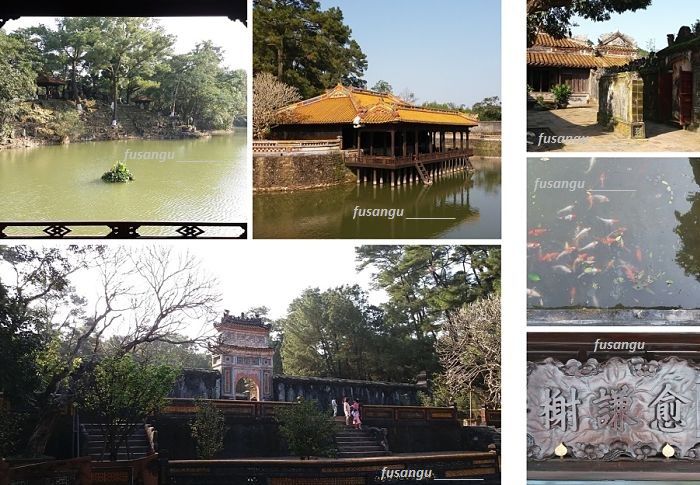
Related articles:
From Hue to Hanoi
You can easily reach Hanoi from Hue by plane, train or bus (in order of decreasing cost and comfort). Travelling by train by night is a an interesting option but flying is the most suitable choice if you seek comfort.
Day 9 – Hanoi | Hoan Kiem Lake, Old Quarter, Vietnamese Women Museum, Water puppetry show
If you choose a hotel in the centre, it is very convenient to get around on foot. The first visit typically starts from the perimeter of Hoan Kiem Lake.
Where to stay in Hanoi
The city centre is the best place where to find accommodation in Hanoi if your stay is so short. Even if the centre is quite small, different areas offer completely different contexts.
The old quarter is the tourist core of the city. You can find lots of restaurants and shops around there but it is rather chaotic and noisy.
A better option is to find a hotel near the Hoan Kiem Lake, especially along the southern and eastern shores. Here are some of the city’s best value for money structures.
High-end hotels are near the western shore, in the so-called French Quarter.
10:00 – 12:00: Hoan Kiem Lake, Jade Mountain Temple
Hoan Kiem Lake is the scenery of one of the founding myths of the Vietnamese nation. According to the myth, Emperor Le Loi had received a magic sword that helped him defeat Ming China. He then returned the sword to the Golden Turtle God (Kim Qui) which appeared while Le Loi was boating on the lake. Hence, this was named Hoan Kiem Lake, “Lake of the Returned Sword”).
The graceful small lake is the cultural and spiritual centre of modern Hanoi and serves as meeting point and venue for important social gatherings.
At the centre of the lake is the Turtle Tower, a small and dignified ancient temple. An elegant wooden bridge leads to the Jade Mountain Temple, a place of worship with a long and complicated history situated on a small island at the north-western corner of the lake.
A ring of tall trees, among which many exhibit wonderful flowering create a physical and symbolic separation from the ordinary city.
12:00 – 13:00: Lunch break and coffee
Along the lake are plenty of restaurants and coffee shops. There is no better place where you can enjoy a Vietnamese coffee. Slowly percolating from the filter, thus necessarily enjoyed in all relax, the drink is indicative of the local attitude towards simple and genuine pleasures and social life.
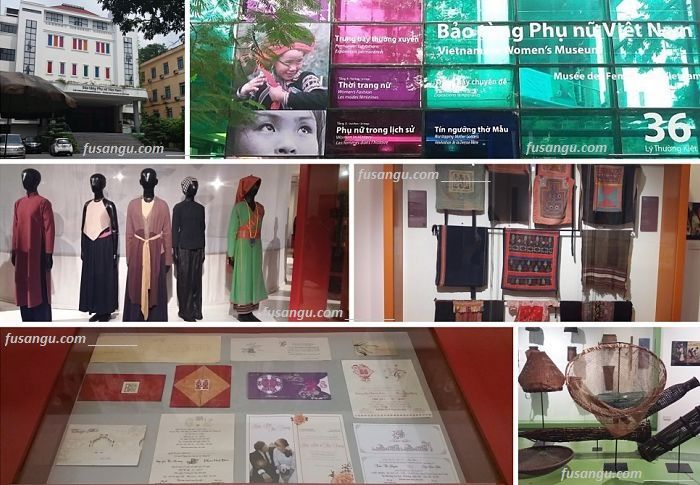
13:00 – 15:00: Vietnamese Women’s Museum
Vietnamese Women’s Museum is definitely one of Hanoi’s most interesting museums. It is located south of Hoan Kiem Lake, not far from the railway station and Hoa Lo Prison Museum, in Hai Ba Trung district.
The museum highlights the role of women throughout the history of Vietnam, with particular emphasis on their contribution to the social life, economy, art and wars for national independence.
The museum allows the visitor to get to know many aspects of the unique and highly distinctive culture of Vietnam and there are many interesting artefacts and items of every day life on display.
15:30 – 17:00: Old Quarter
North of Hoan Kiem Lake lies the so-called Old Quarter, a fascinating maze of narrow and meandering streets where life seems to flow as it used to do in the past.
Though very little remains of the ancient architecture, with the notable exceptions of a few temples and profane buildings, the atmosphere, alternating slowness and frenzy makes it for a must-see destination.
Most streets are named after the good that was traded there. Some have retained the original vocation while others have changed completely.
Not to be missed are a beautiful traditional house at 87 Ma May (Nha Co Di San) and Bach Ma Temple.
In the evening
The Water Puppetry show is an entertaining performance that popularises themes and stories rooted in Vietnam’s history and mythology.
The ancient art was developed along the Red River as a way to educate people. It combines traditional music, dance and poetry.
Regular performances are held at Thang Long Theatre, located near the north-eastern corner of Hoan Kiem Lake.
Day 10 – Hanoi | Ho Tay, Ba Dinh Square, Temple of Literature
The last day in Hanoi is devoted to some Ho Tay, Ba Dinh and Dong Da districts. The areas are not too far from the centre but it is advisable to get around by taxi in order to save time.
08:00 – 9:15: Ho Tay, Tran Quoc Pagoda, Den Thanh Quan
Ho Tay (or Tay Ho, “West Lake”) is a large freshwater lake located north-west of Hanoi’s city centre. Near its shores are a number of ancient temples.
You can start your visit to the area from Tran Quoc Pagoda, Hanoi’s most ancient Buddhist temple. Located on a small peninsula protruding into Ho Tay Lake, surrounded by calm waters and a deep sense of separation from the profane world, the temple makes for a stunning sight.
The temple stands out for its beauty, artistic value and cultural and religious significance.
As you leave the lake you are soon to encounter Den Quan Thanh, an ancient Taoist temple. Inside is a huge bronze sculpture of GuanYu, a Chinese martial deity, highly revered in Vietnam.
9:30 – 11:00: Ba Dinh Square, Ho Chi Minh Mausoleum
Ba Dinh Square is a large space where military parades and manifestations of Vietnam’s patriotism take place. The square separates the National Assembly (Vietnam’s parliament) and Ho Chi Minh Mausoleum, the resting place of modern Vietnam’s national hero.
Entrance to the mausoleum requires appropriate attire and respectful behaviour. After visiting the mausoleum you can see the gardens and Ho Chi Minh’s modest stilt house.
There is also a museum providing plenty of information on Ho Chi Minh and his struggle for national independence.
11:00 – 11:30: One Pillar Pagoda
A few steps away from Ho Chi Minh Mausoleum is the beautiful One Pillar Pagoda (Diên Hựu tự, 延祐寺; Liên Hoa Đài, 蓮花臺), one of Vietnam’s most recognisable symbols and original architectures.
The historic temple was erected by Lý Thái Tông, emperor of the Dai Viet from 1028 to 1054. The childless emperor had dreamed that Quan Am (Avalokiteshvara) seating a lotus flower handed him a baby. The emperor then married a woman who bore him a child. To express his gratitude, Ly Thai Tong built this temple in the shape of a lotus flower. Near the temple is a bodhi tree gifted by India.
The temple was ravaged by the retreating French troops in 1954.
12:30 – 14:00: Van Mieu Quoc Tu Giam
After lunch you can reach the Temple of Literature on foot or by taxi. The Van Mieu (commonly translated incorrectly as “Temple of Literature”) is a large religious complex and the site of Vietnam’s first national university. It was built under the Ly Dynasty and its layout reflects that of Confucius’ Temple in QuFu (ShanDong, China).
Surrounded by a low brick wall, the site is made of five courtyards linked by three parallels pathways.
Inside the first two courtyards are large gardens with ancient trees and trimmed lawns. Between the second and third courtyard is Khue Van Pavilion, the symbol of the city of Hanoi.
In the middle of the temple (third courtyard) is the Thien Quang Tinh (Heavenly Light Spring). On either side of the well are two halls which house the treasures of the temple. Here are rows of large statues of turtles bearing stelae that honour those who took the Imperial Exams.
In the fourth courtyard is the main hall, where Confucius and his disciples are worshipped. The temple is an elegant architecture housing many statues and artefacts.
In the fifth and last courtyard is the Imperial Academy (Quoc Tu Giam). The buildings are reconstructions. The site was destroyed by the French as their rule was collapsing.
The temple is very popular and is regularly a venue for events and rites that celebrate the national culture. It is customary for students to take pictures here upon graduation.
14:30 – 18:00: Choice among four alternatives
There are many different ways of concluding this visit. We suggest the following options:
-
Visit to Vietnam Ethnography Museum, an interesting museum that presents the culture of the numerous peoples living in present-day Vietnam;
-
Visit to Thang Long Citadel, a historical imperial residence, which comprises a small archaeological museum and a bunker used during the last war;
-
A walk in the centre; east of the lake are Saint Joseph’s Cathedral, Ly Trieu Quoc Su Pagoda and Ba Da Pagoda. West of the lake is the so-called French Quarter.
Related articles:
From Hanoi to Sa Pa, overnight
Time is very limited so it is best to reach Sa Pa overnight. You can either take a train to Lao Cai and transfer to Sa Pa by local shuttle bus or travel exclusively by night bus.
Buses leaving at 22:00 reach Sa Pa around 6:00. The ride costs 250.000-350.000 dong depending on the service level.
Day 11 – Sa Pa | Half-day excursion
Sa Pa is a small town at the centre of a region of outstanding natural beauty. It lies in Lao Cai Province, not far from the border with Lai Chau Province.
The city itself has turned into everything that mass tourism should be despised and feared for. A fake, artificial environment that caters to meet basic needs of the cosmopolitan non-cultural world.
The region, inhabited by communities, different to the prevalent Kinh (Viet) ethnic group, is a mosaic of cultural and natural landscapes. Rice paddies adorn valleys and mountains with their hypnotic patterns, small houses retain the shapes and features of the old architecture, life flows slowly in accordance to the rhythm of seasonal changes. You can experience all this only if you get out of the tourist paths or at least venture a bit further away.
Where to stay
Staying at a local guest house is the best way to experience the local culture but be aware of the fact that lazy and spoilt tourists have put so much pressure on the local life that many places lost their authenticity.
In the afternoon
Guided tours allow to grasp sights of the life in the villages near Sa Pa. These villages are mostly inhabited by H’mong and Dao communities. A classic half-day tour includes visits to Lao Chai and Ta Van, the first villages you encounter when you explore the Valley of Muong Hoa.
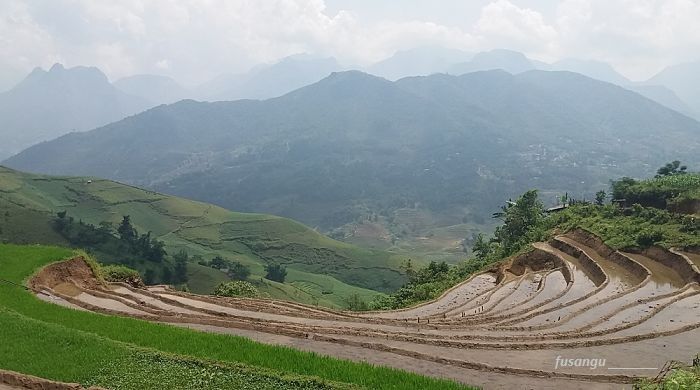
Day 12 – Sa Pa | One-day tour
The next day you can visit Ma Tra and Ta Phin villages. Located north of Sa Pa, they are among the most picturesque and least spoilt landscapes of Sa Pa’s area.
Tours normally include a visit to a local house, basic introduction the customs and aspects of the local culture as well as some simple hands-on activities.
Variant: ascent to Mount Fansipan
With its 3.143 metres of altitude, Fan Si Pan (Phan Xi Pang) is the highest mountain in Vietnam and whole Indochina. A cable car now connects Sa Pa to its summit but if you are a keen hiker you should not miss the chance of ascending the mountain.
As the paths are quite dangerous and weather changes very quickly, independent ascending of Fansipan has been made illegal and the authorities strictly and zealously enforce the ban.
One day is too little time to complete the ascent and descent. Enquire with a tour agency that offers one-day tour. You can reach the summit on foot and get back to Sa Pa by cable car. Hiking on Fansipan requires a fit condition, experience and readiness to face difficulties and discomfort.
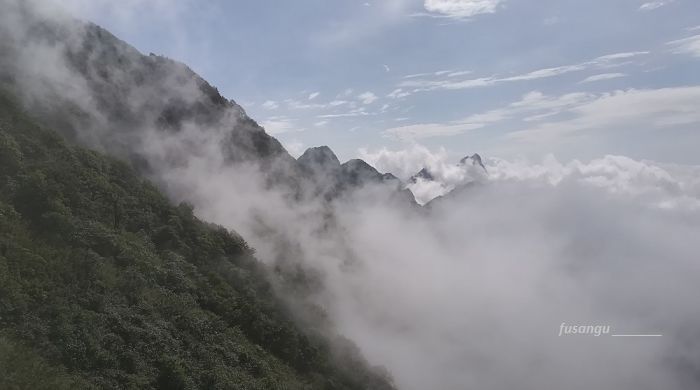
From Sa Pa to Hanoi
You can return to Hanoi overnight following one of the ways described before.
Related articles:
Day 13 – Ha Long Bay cruise
Overnight buses and trains from Sa Pa to Hanoi reach the destination in the early morning, therefore you can immediately move to Ha Long Bay. The transfer, provided by the tour operator that organises the cruise, takes less than 2 hours and a half.
Ha Long Bay is considered as the best destination to finish a journey to Vietnam with. The natural scenery, a myriad of rock islands covered in a thick jungle, is truly impressive. The beauty of the landscape is emphasised by the myths that explain its origin.
Choice of the cruise
As time is limited, we only consider a 2-day cruise for this itinerary. You can easily modify the programme and choose a 3-day cruise if you wish. This allows to get off the beaten tracks and visit Lan Ha and Bai Tu Long bays.
There is plenty of options when it comes to choosing a cruise in Ha Long Bay. Most cruises include some of the following activities:
-
A visit to a floating village
-
Cooking classes
-
Yoga and Tai Chi practice
-
A visit to one or two islands
-
Kayaking
Since you are to stay on a boat for 24 hours, consider carefully what kind of experience you want to have.
You should take into account aspects such as the type and quality of the accommodation, the size of the boat, the number of travellers the boat can accommodate, the menu, the number and variety of activities.
By simply reading reviews by other travellers you can get a reasonable picture of what you can expect.
Day 14 - Return to Hanoi; flight to Ho Chi Minh City; end
After the cruise you go back to Hanoi. Most companies will make sure you are back to Hanoi by 13:00.
If you are to fly to Europe, your flight will most likely leave in the evening or late night. Depending upon the time of departure of your flight to Ho Chi Minh City, you might have some time for buying souvenirs and gifts. Look no further than the area surrounding Lake Hoan Kiem unless you have knowledge of specific shops.
Flights from Hanoi to Ho Chi Minh City are very frequent and many companies operate the route (such as Vietnam Airlines, Vietjet and Bamboo Airways).
